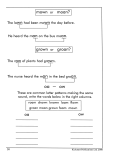Homophones and Tricky Words Book 2
SKU:
978-1-913884-39-0
€19.95
€19.95
Unavailable
per item
Each book provides a wide range of activities for teaching the spelling of 58 homophones and easily confused words. The breadth of activities ensures that this resource can be used effectively at primary and secondary school with pupils having a range of Learning Difficulties. Provides strategies for remembering spellings, activities to practise and consolidate using cloze activities, word searches, Look, Say, Cover, Write, Check methods, and proof reading. Includes dictation sentences for identifying difficulties, pupil response sheets, and checklists. 80 pages each book.
TEACHING NOTES
Correcting Spellings
Many pupils experiencing difficulty with this area of the curriculum will have a poor self image and will see themselves as poor spellers. They will benefit from seeing the correction of spelling errors as a positive activity. The following procedure for correcting errors will help.
1.The pupil is asked to read through the work highlight words thought to be spelt incorrectly.
2.The teacher uses a different colour to highlight errors missed by the pupil and words highlighted which are spelt correctly.
3.The two scores are recorded on the work ~ the pupil usually wins.
4.The teacher uses a third colour to highlight words spelt correctly which have previously caused difficulties. Generous praise is helpful here.
5.The teacher and pupil select a number of errors and compare the pupils spelling with the correct spelling to identify the part of the word causing difficulty.
6.The correct spellings of the words selected are written down and, where possible, further words with the same letter pattern are written alongside each word. The pupil should work with the teacher to think of additional words.
7.The words listed can be practised using a variation of the Look, Say, Cover, Write check method.
TEACHING NOTES
Correcting Spellings
Many pupils experiencing difficulty with this area of the curriculum will have a poor self image and will see themselves as poor spellers. They will benefit from seeing the correction of spelling errors as a positive activity. The following procedure for correcting errors will help.
1.The pupil is asked to read through the work highlight words thought to be spelt incorrectly.
2.The teacher uses a different colour to highlight errors missed by the pupil and words highlighted which are spelt correctly.
3.The two scores are recorded on the work ~ the pupil usually wins.
4.The teacher uses a third colour to highlight words spelt correctly which have previously caused difficulties. Generous praise is helpful here.
5.The teacher and pupil select a number of errors and compare the pupils spelling with the correct spelling to identify the part of the word causing difficulty.
6.The correct spellings of the words selected are written down and, where possible, further words with the same letter pattern are written alongside each word. The pupil should work with the teacher to think of additional words.
7.The words listed can be practised using a variation of the Look, Say, Cover, Write check method.






